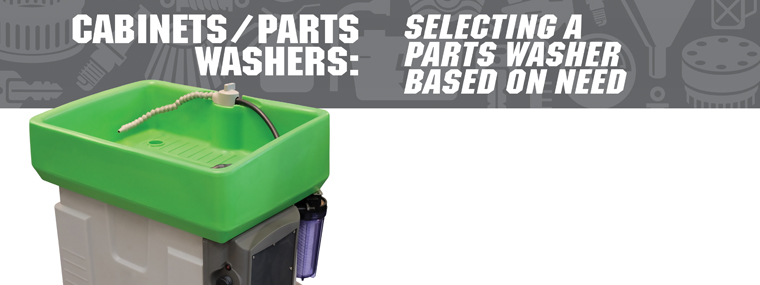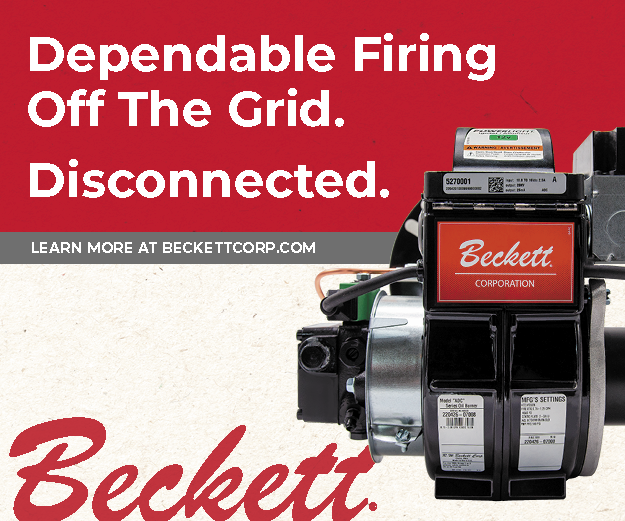
Cabinets/Parts Washers: Selecting a Parts Washer Based on Need
By Diane M. Calabrese / Published September 2016

Bicycle chains gave most of us an early introduction to the obstacle organic residue is to repairs. A chain broke. We could fix it. To do the repair the right way, we had to first clean the chain. A small amount of an organic solvent and some dipping or dabbing did it.
Easy enough, but multiplied by all the parts—auto, engine, heavy machinery, and more—that must be cleaned before they can be refurbished, organic solvents extract a toll on human health (through direct inhalation, ingestion, or skin absorption) and the environment. Today, using volatile organic compounds (VOCs) is avoided whenever possible.
Hot water and mechanical force (via spray, agitation, or both) have been tapped for decades to do what otherwise might be accomplished with VOCs. By designing cabinets in which to clean parts with water, industrial engineers accomplished two things: a reduction in use of VOCs and ease of collection (with proper disposal) of residue, such as oil and sludge.
The sophistication of parts washers today reflects engineering talent that could easily get us to the moon and beyond on a regular basis. Spray angles change, parts rotate, water use is minimized, and so on.
A parts washer can be selected based on need. Perhaps the cleaning to be done is light; in that case simplicity in the washer ought to be sought. That’s a reminder from J. Wes Godfrey, a principal at Temco in Oklahoma City, OK.
Godfrey has been involved in the refinement of parts washers since 1978, when, as an expert in controls, he looked at the control system on a parts washer at the request of some-
one. As he began to get more and more requests to “tweak” systems, he developed ideas about how to construct a better parts washer.
By the early 1990s, Godfrey realized something else. “I could see solvents going away with all the regulations,” he explains. “Water and soap were going to be the way.”
Although Godfrey made suggestions to others, he eventually reached a decision that he shared with his son, telling him, “To get what we want, we’re going to have to build our own.” That was in 1991.
Many changes to parts washers have made them better. One was “the advent of the oil skimmer,” says Godfrey. “It allows the manufacturer to build a smaller reservoir.”
Ideas for improvement come from the strong involvement that the team at Godfrey’s company has with customers. They know how parts washers are being used. “We’ve had a chance to look at them up close and personal in the field out there,” he says.
About four years ago, Godfrey’s company introduced a new feature to prevent tangling. “We’ve done a notchback so loading with overhead cranes is easier,” he explains.
“We listen to everybody who uses these things because those people in the trenches know what they need,” says Godfrey. He adds that in reality “most people shop online these days.”
The web shopping does not preclude the exchange of information. “Our best salesman is the web,” says Godfrey. “Still, when they have everything identified they want, it’s still important to talk with someone.”
To promote information exchange, Godfrey has prepared eight tips for selecting a parts washer (www.washparts.com/content/16-the-8-musts-to-select-an-industrial-parts-washer). Each tip derives from the extensive experience he has had consulting with users.
For example, buying a more complicated parts washer than needed may result in more time spent on maintenance. Godfrey’s succinct and lucid tips are a perfect place for individuals choosing their first parts washer to get grounded, and for veteran users of parts washers to check themselves on their approach.
Looking Forward
Manufacturers of cabinet washers look ahead with enthusiasm and ingenious thoughts. The idea that the cabinet washer has attained the pinnacle of design just does not exist. Excellence, as we have noted in the past, begets more of the same through a sustained effort to surpass.
“Our company has made two large innovations to cabinet washers in the last couple of years,” says Jeff Brouchoud, president of Alliance Manufac-turing Inc. in Fond Du Lac, WI.
He explains, “Cabinet washers traditionally have a rotating table with a center bearing located under the table. This bearing creates a blind spot for cleaning parts. Our company’s newest generation of cabinet washers has no center bearing, allowing operators to load parts anywhere on the table with uniform cleaning results. In addition, this new centerless bearing design allows added room for additional spray manifolds so cleaning times are shortened when compared to conventional cabinet washers.
“Our company has also developed an option incorporating removable tooling for cleaning complex parts with tight cleanliness requirements,” continues Brouchoud. “We start with a standard cabinet design, but remove the rotating table and spray system. Removable ‘interchangeable’ tooling designed for a specific part(s) is bolted into the machine. This tooling includes a part-specific spray system with nozzles positioned to clean targeted holes/part features included with the interchangeable tooling. If a part program comes to an end, the base machine can be re-utilized for future programs by simply changing out the part tooling.”
Customers, again, are a vital source of information. “In our particular case, customer feedback plays a major role in the development of new machines and/or machine features,” says Brouchoud. “The interchangeable tooling innovation was the direct result of listening to customer requirements and modifying a standard cabinet design to fill those needs.”
Parts washers fill important roles in industry. For one, they allow components and machines to attain their greatest longevity. Often overlooked by those who focus on carbon emissions is the reduction that can be achieved by using equipment (and buildings) longer. Increasing life span of equipment includes choosing the optimal parts washer.
To get the parts washer that will be a good fit, take advantage of the ex-
pertise of the manufacturer. “My best advice is for the end user to clearly define their cleaning need and desired result,” says Brouchoud.
Convey all the relevant information to the manufacturer. “This typically involves supplying drawings, perhaps sample parts and related information such as production rate, cleanliness requirements, desired dryness, etc.,” says Brouchoud. “Then rely on the cleaning equipment manufacturer to present the best solution for the application. In my opinion, we would prefer the end user not specify machine features. They should rely on the expertise of the washer manufacturer to propose the best equipment for their application.”
Cabinet and Conveyor
Brouchoud reminds us that we should clarify one point. “Cabinet washers are typically used for lower production rates,” he explains. “Higher production rates typically involve conveyor cleaning systems.”
Enclosures for conveyor-based systems are analogous to cabinets in the sense that they offer containment. The one-way movement of items to be cleaned distinguishes conveyor systems from a cabinet that is loaded and unloaded through the same portal.
Parts must be cleaned in every type of industry. Some settings really have zero tolerance for residue post cleaning. They include the aerospace industry and the pharmaceutical industry, where ultrasonic cleaning is often done alone or in addition to washing.
Biomedical devices and implants also must be cleaned prior to use. Standards are so exacting that water-testing systems to monitor water chemistry may be built in to parts cleaning systems. Chambers that house parts cleaning agents must be kept clean. Eliminating contamination of any sort in a chamber used for cleaning—whether aqueous, ultrasonic, solvent or other—is part of the design process. Air is filtered. Functions—e.g., mold removal—are separated from one another.
Across all sectors, the goal among manufacturers of parts washers is to accomplish the task with the most environmentally friendly approach possible. True, in some cases, particularly related to biomedical concerns, chemicals must be used. For industrial applications, however, heat, water, and biodegradable detergents meet most needs of parts washers. In November 1999, the Environmental Protection Agency published a brochure on Aqueous Parts Cleaning Best Practices for Auto Repair (www3.epa.gov/region9/waste/p2/autofleet/autoclean.pdf). The document is timeless in most ways and recommended.
For one, there are some myths that the document aims to bust. Consider the myth about rust, which applies today. Rust inhibitors in aqueous cleaners, which have only been improved in the last 17 years, work.
And the brochure includes a do-and-don’t graphic for aqueous cleaning with cabinets. Not surprisingly, the do list is routinely met by manufacturers of parts washers in 2016. That is, parts are dried immediately after cleaning (to thwart rust formation), oil is skimmed, filtration is used (to give longer solution life), and units are demonstrated.
Finally, using a parts washer correctly encompasses proper disposal of all residue, including hazardous waste. Industrial cleaning can remove heavy metals that are classified as hazard-
ous material by federal, state, or local authorities. Owners of parts washers have the responsibility to meet all legal requirements, which may involve licensing fees and other payments.





